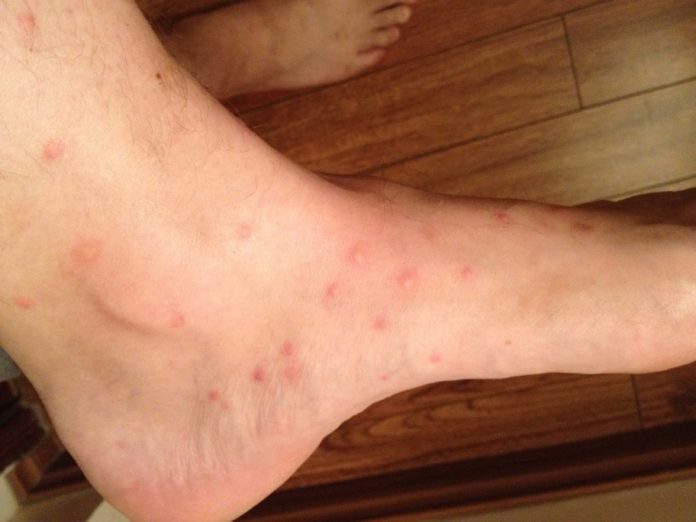What do sand flea bites look like? A lot of people have been searching for the answer to this question along with the ways to avoid them. Don’t worry! We have written this article for you which will solve all your problems!
The sand flea lives in seashores and buries in the sand or fur of animals. They are small, brown, or grey, and their bites are painless. Therefore, you will not be able to understand when they bury their heads in your skin. Regarding what sand flea bites look like, these appear in a red itchy, raised pimple that might spread with scratching.
It is better to visit the beach during the daytime to avoid them and keep your feet well covered. Insect sprays and repellents also work effectively. Avoid scratching.
How to Identify a Sand Flea Bite?
Since sand fleas are not big but microscopic, identifying them can be difficult. You could be seated on the sand by the sea and be gifted with a red ring bite mark without any notice. These crab-like crustaceans are small and light brown (they camouflage with the color of sand). A strong exoskeleton protects their body; their light body also gives them a jumping ability of almost 15 inches. These fleas are common inhabitants in coastal areas, seashores, and sometimes, sandy marshes.
What Is the Difference Between Sand Fleas and Sand Flies?
The sand fly, Tunga penetrans (the “genuine” sand flea or chigoes), and the arthropod from the family Talitridae are all examples of animals that can be referred to as sand fleas. Although they are all arthropods, none of these organisms are arranged in the same order. True flies that have teeth are sand flies. In general, sand fly bites hurt and might result in blisters and red lumps. These lumps and blisters may develop into infections or result in dermatitis, an inflammation of the skin. Leishmaniasis is a parasitic disease that is spread by sand flies to both humans and animals.
What Is the Difference Between Sand Fleas and Regular Fleas?
Both varieties of fleas can thrive on domestic and wild animals. Additionally, they can both spread sickness. Sand fleas, on the other hand, live on people, but ordinary fleas do not. The other distinction is that, unlike sand fleas, ordinary flea bites don’t frequently result in deep skin sores.
Symptoms of Sand Flea Bites
Some of the symptoms are:
- Inflamed spots, often with a darker spot in the middle.
- Itchy.
- Arranged in a rough line or in a cluster.
- Located on the face, neck, arms, and hands.
How to Know if It Is Sand Flea Bites?
Although not all sand fleas are the ones that feed or bite humans, they do leave itchy, hurtful bites. These crustaceans are active during the early and late hours of the day, making you an easy target if you visit the beach around dawn or dusk. The bite looks like small, red, raised bumps on the skin. They mainly attack the lower body like the claves, shins, ankles, or feet.
The bites can be pretty itchy and painful. You might as well be cautious. As mentioned above, sand fleas are active during the early mornings and late evenings. They stay in their sand burrows during midday or bright time of the day. So, stay clear of the beach around the break of day and the twilight to avoid the sand flea bites. Wet conditions and damp weather elevate the flea’s activity.
The bites are red, with pimple-like bumps. Some look like hives or a rash with red bumps. There is a possibility the area might have minor swelling. The redness lasts from hours to days, depending on person to person. Avoid scratching the spot. This will help it heal faster.
3 Effective Ways to Avoid Sand Flea Bites

- One of the perfect ways to avoid sand flea bites is to go to the beach at the right time of day. Visiting the beach early in the morning or late in the evening increases the likelihood of having sand flea bites. On the other hand, sand fleas are the least active during the daytime. You’re less likely to suffer from sand flea bites by avoiding the beach around dawn and dusk.
- Cool, wet conditions also tend to heighten sand flea activity. As a result, it’s perfect to avoid the beach after it rained to minimize your chances of being bitten. Windy days can also reduce the likelihood of sand flea bites. If you find yourself on the beach when it’s cool and wet or spend time at the beach around dawn or dusk, do your best to keep moving. Sitting or lying on the sand makes you an easier target for bites. Do your best to keep your feet, ankles, and lower legs covered.
- Commercial insect sprays and repellents can help ward off certain types of sand fleas, although they’re not effective against all of them.
Closing Thoughts
First and foremost, do your best to resist the urge to scratch sand flea bites. Scratching will only irritate your skin further, and excessive scratching can increase the chances of suffering from a skin infection.
Over-the-counter anti-itch creams containing hydrocortisone can help to reduce inflammation and cut down on itching. Some individuals find that aloe vera gel is cooling and soothing for bites, while others successfully reduce itchiness with a colloidal oatmeal bath. Tea tree oil, witch hazel, and vinegar also work well.
You can also check out:




